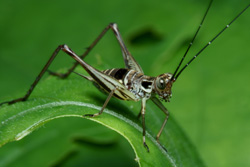Predator detection system of the wood cricket
This study examined the sensing system of wood crickets by tracking their air currents' perception. Based on bio-electronic technologies, the scientists evaluated the behaviour of the mechanoreceptor hairs on the cricket, which respond to the stimuli from attacking predators. The main results collected led to a number of interesting conclusions. Firstly, it was noted that juvenile crickets differ from the older ones in their response to the predator (the spider). The younger insects were observed to hide under leaves. Secondly, it appeared that the predator employed two tactics to avoid the detection system of the wood crickets. It either attacked very quickly, thereby surprising its prey, or very slowly, in order to mitigate its intention to attack. Understanding of the importance of the airflow around the sensory system of the cricket improved throughout the study. It was found to be characterised by a high density of non-interacting short hairs at the base of the cercus. This is where sensitivity to air currents is highest. The CICADA project achieved a better understanding of the physiological basis of sensing. The information gathered will be transferred to the development of highly integrated artificial life-like miniature systems. The project also increased the advancement of biometric simulated perception systems. This allowed scientists to assess the relative importance of variables on performance and to provide conceptualisation tools for the design of biometric man-made sensors.







